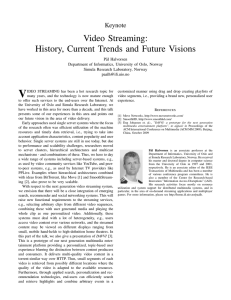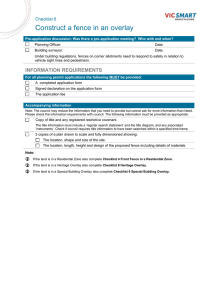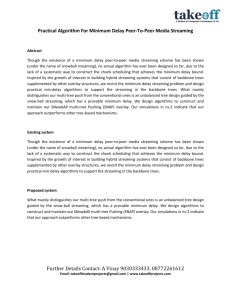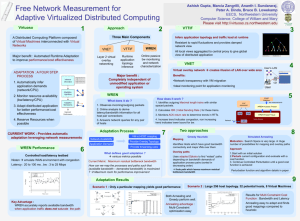A BENCHMARKING SYSTEM FOR MULTIPATH OVERLAY MULTIMEDIA STREAMING
advertisement
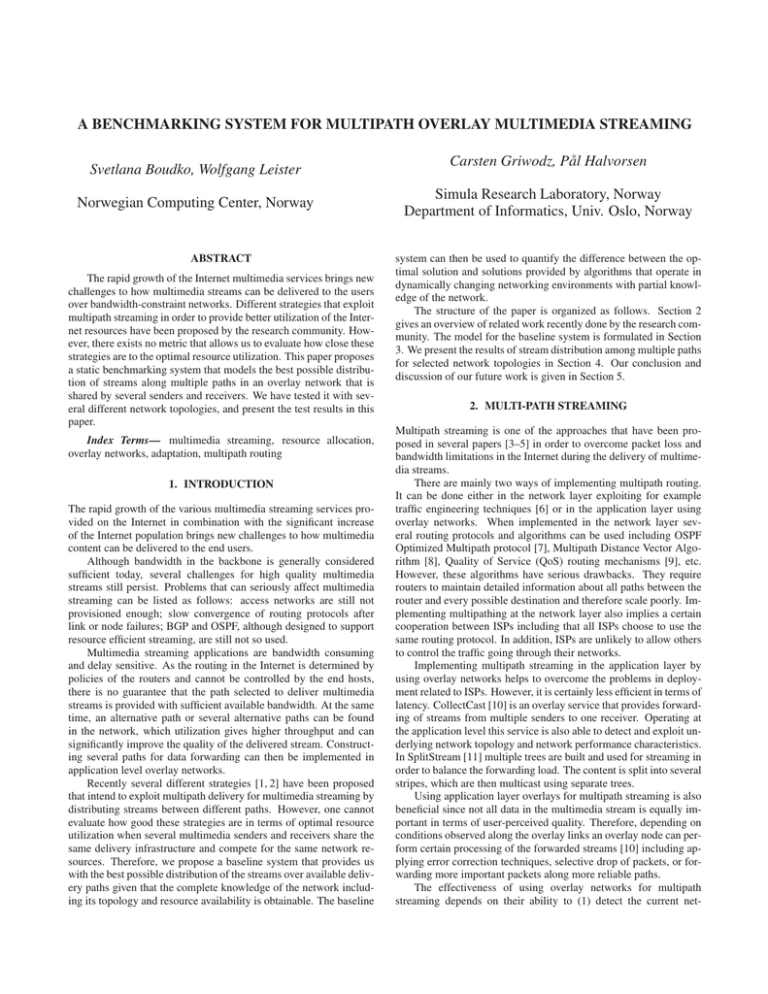
A BENCHMARKING SYSTEM FOR MULTIPATH OVERLAY MULTIMEDIA STREAMING
Svetlana Boudko, Wolfgang Leister
Norwegian Computing Center, Norway
ABSTRACT
The rapid growth of the Internet multimedia services brings new
challenges to how multimedia streams can be delivered to the users
over bandwidth-constraint networks. Different strategies that exploit
multipath streaming in order to provide better utilization of the Internet resources have been proposed by the research community. However, there exists no metric that allows us to evaluate how close these
strategies are to the optimal resource utilization. This paper proposes
a static benchmarking system that models the best possible distribution of streams along multiple paths in an overlay network that is
shared by several senders and receivers. We have tested it with several different network topologies, and present the test results in this
paper.
Index Terms— multimedia streaming, resource allocation,
overlay networks, adaptation, multipath routing
1. INTRODUCTION
The rapid growth of the various multimedia streaming services provided on the Internet in combination with the significant increase
of the Internet population brings new challenges to how multimedia
content can be delivered to the end users.
Although bandwidth in the backbone is generally considered
sufficient today, several challenges for high quality multimedia
streams still persist. Problems that can seriously affect multimedia
streaming can be listed as follows: access networks are still not
provisioned enough; slow convergence of routing protocols after
link or node failures; BGP and OSPF, although designed to support
resource efficient streaming, are still not so used.
Multimedia streaming applications are bandwidth consuming
and delay sensitive. As the routing in the Internet is determined by
policies of the routers and cannot be controlled by the end hosts,
there is no guarantee that the path selected to deliver multimedia
streams is provided with sufficient available bandwidth. At the same
time, an alternative path or several alternative paths can be found
in the network, which utilization gives higher throughput and can
significantly improve the quality of the delivered stream. Constructing several paths for data forwarding can then be implemented in
application level overlay networks.
Recently several different strategies [1, 2] have been proposed
that intend to exploit multipath delivery for multimedia streaming by
distributing streams between different paths. However, one cannot
evaluate how good these strategies are in terms of optimal resource
utilization when several multimedia senders and receivers share the
same delivery infrastructure and compete for the same network resources. Therefore, we propose a baseline system that provides us
with the best possible distribution of the streams over available delivery paths given that the complete knowledge of the network including its topology and resource availability is obtainable. The baseline
Carsten Griwodz, Pål Halvorsen
Simula Research Laboratory, Norway
Department of Informatics, Univ. Oslo, Norway
system can then be used to quantify the difference between the optimal solution and solutions provided by algorithms that operate in
dynamically changing networking environments with partial knowledge of the network.
The structure of the paper is organized as follows. Section 2
gives an overview of related work recently done by the research community. The model for the baseline system is formulated in Section
3. We present the results of stream distribution among multiple paths
for selected network topologies in Section 4. Our conclusion and
discussion of our future work is given in Section 5.
2. MULTI-PATH STREAMING
Multipath streaming is one of the approaches that have been proposed in several papers [3–5] in order to overcome packet loss and
bandwidth limitations in the Internet during the delivery of multimedia streams.
There are mainly two ways of implementing multipath routing.
It can be done either in the network layer exploiting for example
traffic engineering techniques [6] or in the application layer using
overlay networks. When implemented in the network layer several routing protocols and algorithms can be used including OSPF
Optimized Multipath protocol [7], Multipath Distance Vector Algorithm [8], Quality of Service (QoS) routing mechanisms [9], etc.
However, these algorithms have serious drawbacks. They require
routers to maintain detailed information about all paths between the
router and every possible destination and therefore scale poorly. Implementing multipathing at the network layer also implies a certain
cooperation between ISPs including that all ISPs choose to use the
same routing protocol. In addition, ISPs are unlikely to allow others
to control the traffic going through their networks.
Implementing multipath streaming in the application layer by
using overlay networks helps to overcome the problems in deployment related to ISPs. However, it is certainly less efficient in terms of
latency. CollectCast [10] is an overlay service that provides forwarding of streams from multiple senders to one receiver. Operating at
the application level this service is also able to detect and exploit underlying network topology and network performance characteristics.
In SplitStream [11] multiple trees are built and used for streaming in
order to balance the forwarding load. The content is split into several
stripes, which are then multicast using separate trees.
Using application layer overlays for multipath streaming is also
beneficial since not all data in the multimedia stream is equally important in terms of user-perceived quality. Therefore, depending on
conditions observed along the overlay links an overlay node can perform certain processing of the forwarded streams [10] including applying error correction techniques, selective drop of packets, or forwarding more important packets along more reliable paths.
The effectiveness of using overlay networks for multipath
streaming depends on their ability to (1) detect the current net-
The second one is the latency function that defines the latency of the
arc a:
l : A → R0+
(3)
The same functions are defined on the paths. The available bandwidth of the path p is defined as the lowest bandwidth among all
arcs that belong to the path p:
b(p) = min{b(a)}, a ∈ p
(a) Total throughput between one receiver and one
sender.
The latency of the path p is the sum of all latencies of the arcs that
belong to the path p:
X
l(a)
(5)
l(p) =
a∈p
(b) Shared link.
Fig. 1. Link and path constraints.
work conditions such as latency and available bandwidth and (2)
avoid using points of shared congestion. Available network resources can be detected using network tomography and inference
techniques [12].
Research in defining correlation techniques for detecting shared
congestion has been done by the authors [13]. However, in spite of
the considerable amount of work that has been done in the area, we
have so far found only examples that demonstrate improved performance over other ad-hoc mechanisms or over unicast performance.
We have therefore decided to create the benchmark for optimal performance presented in the next section.
3. BENCHMARK
To build our benchmarking system, we model the overlay network
that includes senders, receivers and overlay nodes as a fully meshed
graph Do = (V o , Ao ), where V o is the set of vertices that represents
the nodes of the network, and Ao is the set of arcs that represent the
overlay links between the nodes. Sets Vso ∈ V o , Voo ∈ V o and
Vro ∈ V o are disjoint subsets of vertices representing respectively
sender nodes, overlay nodes and receiver nodes.
In the overlay graph, we define a set of all possible overlay paths
between the receivers and the senders. Note that these paths should
not contain loops. For each overlay path, we build a corresponding
path in the underlying Internet connecting the vertices of the overlay
path by the shortest paths in the underlying network. Thus, we define
a set of all possible paths P in the underlay. Then, pki,j denotes the kth path of the subset which contains the paths connecting the sender
i with the receiver j. Ki,j denotes the number of paths from the
sender i with the receiver j.
The intersection of all paths P forms the underlay graph D =
(V, A), where V is the set of vertices representing the nodes of the
underlying network and A is the set of arcs representing the underlay
links. For each path p and each ark a in the underlay graph we define
a function δ as follows:
(
1, if a ∈ p
(1)
δ(a, p) =
0, if a ∈
/p
To model network resources we define two functions on the underlay arcs. One is the bandwidth function that expresses the available bandwidth of the arc a:
b : A → R0+
(4)
(2)
Streaming requirements of the requested streams are defined by
the matrix R, where the matrix element ri,j represents the required
bitrate at which the stream from the sender vsi is streamed to the
receiver vrj . In addition, we define the matrix Rb which is similar to
the above matrix r, but contains the bitrates for the basic layers. The
basic layer represents the lowest acceptable perceived quality of the
multimedia content.
One more matrix used to specify the receivers’ requirements for
stream delivery is matrix D. Its elements show the acceptable delay
for stream arrival to the receivers. The values for these elements can
differ significantly depending on the nature of the streaming content.
Live streaming is more delay sensitive than on-demand streaming or
video downloading.
The stream distribution problem is specified as the following.
The streams requested by the receivers have to be distributed among
the paths in a way that the overall throughput of the system is maximized while the delivery of the basic layer is guaranteed. This
problem can be formulated as a linear programming problem, and
to solve it we apply the Simplex method [14].
We introduce the variable xki,j that denotes a share of the mulj
timedia stream sent from the content provider vSi to the receiver vR
through the path k. To find the best possible distribution of the sending streams among the available paths, we maximize the following
objective function:
X k
xi,j · ri,j
(6)
max
pk
i,j ∈P
The objective function is subject to the set of constraints given below.
As not all data in the multimedia stream is equally important for
the perceived quality, we may drop less important data though the
delivery of the basic layer should be guaranteed for all streams:
X
b
∀{i, j} :
xki,j · ri,j ≥ ri,j
(7)
k=0,Ki,j
The next constraint is illustrated in Fig. 1(a). It implies that the
sum of sending rates along all paths from one sender to one receiver
should not exceed the bitrate assigned to this stream.
X
∀{i, j} :
xki,j ≤ 1
(8)
k=0,Ki,j
As depicted in Fig. 1(b) the links in the underlay can be shared between several delivery paths. We need to specify that the total sending rate does not exceed the available bandwidth of the shared link.
X k
xi,j · ri,j · δ(a, pki,j ) ≤ b(a)
(9)
∀{a} :
pk
i,j ∈P
Fig. 2. Example for Waxman topology.
Finally, the latency of the paths participating in delivering a particular stream should not exceed the acceptable delay assigned to this
stream.
l(pki,j ) ≤ di,j
(10)
The objective function and the set of constraints described in
this section define our benchmarking system. This system provides
a reference for dynamic algorithms since it selects paths in a multisource, multi-destination streaming scenario in such a way that the
global resource usage is optimal. Although the system is not practically applicable because of the algorithm’s execution time and the
amount of information, which is needed to be collected in real time
in order to execute the algorithm, it provides a means of comparing the performance of other algorithms with respect to the optimal
choice of paths. We see it as an alternative to simply comparing with
another ad-hoc strategy.
In the following section, we demonstrate the results of the
benchmark for two example scenarios.
4. USAGE EXAMPLE
Our benchmark computes the optimal bandwidth assigment for a
given static network condition and application situation. It is not a
topic of this paper to compare any existing multipath streaming technique with this benchmark, but we consider it necessary to demonstrate that the optimal multipath streaming decision does not have a
trivial solution in the general case. We have done this by applying
the benchmark computation to several topologies and overlay node
placements. Here, we show only two examples.
One of the examples is that of two senders, two receiver and
two overlay nodes that were randomly placed in a Waxman topology, a typically considered a fairly realistic generation strategy for
networks. The Waxman topology depicted in Fig. 2 was generated
using the Brite topology generator [15]. In the second example, we
placed the same number of nodes randomly in a chessboard topology of edge length 6. This topology, the vertex labels and the link
bandwidth resources are depicted in Fig. 3.
We applied the benchmark to these two situations, where both
senders sent one stream to each receiver. For comparison, we computed also the through achievable in a unicast approach that used a
direct shortest path route between each pair of sender and receiver.
Fig. 3. Example for Chessboard topology.
Shortest
path
from
vs1
vs2
sending rate
distribution for Waxman
to vr1
to vr2
42.5
87.0
42.5
39.0
sending rate
distribution for Chessboard
to vr1
to vr2
23.0
25.0
25.0
35.0
Table 1. Total sending rate using shortest path routing.
The throughput achieved in the shortest-path unicast case is then reported in Table 1, the throughput achieved using the benchmark’s
optimization is shown in Table 2. The latter table shows also how
much of the throughput is due to each of the individual paths between a sender and a receiver. These individual path use optionally one or more of the overlay nodes and contribute to the overall
throughput achieved between this pair, while cooperating with the
other sender-receiver pairs in the consumption of the underlay links’
resources to achieve the optimal overall throughput.
We see cleary that the benchmark achieves a much higher perpair throughput than the shortest path approach, but this is to be expected for non-trivial topologies. However more importantly, when
the benchmark assigns the bandwidth shares of the individual overlay paths that are available to each sender-receiver pair, it has to do
this in a non-trivial way to achieve the optimum throughput. We
can even see that considerable resources are gained from using nontrivial paths. In case of the chessboard configuration, we can even
see that a non-trivial path (vs2 → vo2 → vr1 ) contributes the largest
share to the overall throughput for one pair.
We are therefore confident that meeting the limits of achievable
bandwidth is a challenge for ad-hoc multipath streaming decision
mechanisms. In creating our benchmark, we have gained a means of
evaluating the performance of dynamic mechanisms for their potential for further improvement.
5. CONCLUSIONS AND FUTURE WORK
We have presented a benchmarking system for multipath media
streaming of scalable media which we have applied to different
Overlay
path
from
through
vs1
vs1
vs1
vs1
vs1
sum
vo1
vo2
vo1 , vo2
vo2 , vo1
vs2
vs2
vs2
vs2
vs2
sum
vo1
vo2
vo1 ,
vo2 ,
vo2
vo1
sending rate
distribution for Waxman
1
to vr
to vr2
sending rate
distribution for Chessboard
1
to vr
to vr2
32.0
10.1
9.8
1.0
9.1
62.0
31.0
10.8
10.1
7.3
5.7
64.9
19.0
7.5
2.2
2.0
1.0
31.7
11.0
1.6
10.0
1.8
2.3
26.7
87.0
11.0
0.5
6.0
5.6
110.1
39.0
8.0
12.0
3.0
6.0
68.0
12.0
6.0
26.0
0.7
1.1
45.8
34.0
1.0
4.0
1.1
0.7
40.8
Table 2. Distribution of sending rates along overlay paths.
network topologies. For a given topology and set of overlay nodes it
determines, for a given streaming demand, the optimal allocation of
link bandwidth with the goal of allocating the maximum bandwidth
to each of the streams. As bandwidth demands for streams may
vary widely, alternative optimization goals could be achieved by
modifying equation 1, in order to maximize the bandwidth assigned
to a stream relative to its minimal bandwidth.
Since the calculation is rather computing-intensive, and since the
knowledge of the entire system state is necessary for the calculation
this method is not suited for an implementation on a network node
due to scalability reasons. However, our benchmarking system will
be used to compare other algorithms with the optimal case provided
by this work.
We plan to implement multipath streaming solutions from the literature and use the results of the benchmark to evaluate how closely
these overlay solutions can track the optimal resource utilization decision in situations where the network conditions are changing dynamically.
As a further step, we intend to develop distributed algorithms
that operate under partial knowledge of the network topology and
dynamically changing networking parameters such as available
bandwidth and packet loss. These algorithms are then to be integrated into the overlay node together with other basic streaming
functionalities. These can include stream caching, transcoding of
multimedia content, error correction mechanisms, etc., and will
require considerable extension of the benchmark as well.
Another important issue is the interaction between the overlay
network and wireless access networks especially in connection with
handovers between two access networks [16]. It is important to consider how signaling between the mobile device and the overlay net is
handled. Signaling should be done so that both the terminal mobility
and the session mobility are provided for the users.
6. ACKNOWLEDGMENTS
The work presented in this paper has been conducted as a part of the
Adimus (Adaptive Internet Multimedia Streaming) project funded
by the Nordunet-3 program.
7. REFERENCES
[1] Dan Jurca and Pascal Frossard, “Distributed media rate allocation in overlay networks,” in 2006 IEEE International Conference on Multimedia and Expo, July, 2006, vol. 9-12, pp. 1401
– 1404.
[2] Dan Jurca and Pascal Frossard, “Video packet selection and
scheduling for multipath streaming,” IEEE Transactions on
Multimedia, vol. 9, no. 3, pp. 629–641, April 2007.
[3] L. Golubchik, J. Lui, T. Tung, A. Chow, W. Lee, G. Franceschinis, and C. Anglano, “Multi-path continuous media streaming:
What are the benefits,” 2002.
[4] John G. Apostolopoulos and Mitchell D. Trott, “Path diversity
for enhanced media streaming,” Communications Magazine,
IEEE, vol. 42, pp. 80– 87, 2004.
[5] H. Chu and K. Nahrstedt, “Dynamic multi-path communication for video traffic,” in Proceedings of the Thirtieth Hawaii
International Conference on System Sciences, 1997, vol. 1, pp.
695–704.
[6] Attila Takács, András Császár, Róbert Szabó, and Tamás Henk,
“Generic multipath routing concept for dynamic traffic engineering,” in Communications Letters, IEEE, 2006, vol. 10, pp.
126 – 128.
[7] C. Villamizar, “Ospf optimized multipath (ospf-omp),” in Proceedings of the forty-fourth Internet Engineering Task Force,
1999, pp. 45–54.
[8] P. Narvaez, K.-Y. Siu, and H.-Y Tzeng, “Efficient algorithms
for multi-path link-state routing,” .
[9] R. Guerin, A. Orda, and D. Williams, “Qos routing mechanisms and ospf extensions,” 1996.
[10] Mohamed Hefeeda, Ahsan Habib, Boyan Botev, Dongyan Xu,
and Bharat Bhargava, “Promise: peer-to-peer media streaming
using collectcast,” in MULTIMEDIA ’03: Proceedings of the
eleventh ACM international conference on Multimedia, 2003,
pp. 45–54.
[11] M. Castro, P. Druschel, A. Kermarrec, A. Nandi, A. Rowstron,
and A. Singh, “Splitstream: High-bandwidth multicast in cooperative environments,” 2003.
[12] Tian Bu, Nick Duffield, Francesco Lo Presti, and Don Towsley,
“Network tomography on general topologies,” in SIGMETRICS ’02: Proceedings of the 2002 ACM SIGMETRICS international conference on Measurement and modeling of computer systems, 2002, pp. 21–30.
[13] D. Rubenstein, J.F. Kurose, and D.F. Towsley, “Detecting shared congestion of flows via end-to-end measurement,”
IEEE/ACM Transactions on Networking, vol. 10, no. 3, pp.
381–395, June 2002.
[14] William H. Press, Saul A. Teukolsky, William T. Vetterling,
and Brian P. Flannery, Numerical Recipes 3rd Edition The Art
of Scientific Computing, Cambridge University Press, 2007,
ISBN 13:9780521880688.
[15] A. Medina, A.Lakhina, I. Matta, and J. Byers, “Brite: An
approach to universal topology generation,” in MASCOTS
’01: Proceedings of the International Workshop on Modeling,Analysis and Simulation of Computer and Telecomunications Systems, 2001.
[16] Tiia Sutinen and Tapio Frantti, “Reference service architecture for multimedia services in heterogeneous multi-access networks,” in Mobilware’08: Conference on MOBILe Wireless
MiddleWARE, Operating Systems, and Applications, 2008.

